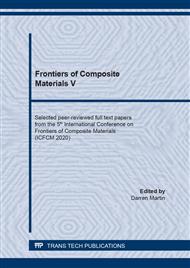p.3
p.11
p.17
p.23
p.29
p.37
p.47
p.57
Synthesis and Characterization of Microcellular Injection Molded Polyolefin/Polycaprolactone Composites
Abstract:
This study investigated the effect of polycaprolactone (PCL) loading (0.5, 1, and 3 wt%) on the morphology, tensile strength, and thermal properties of microcellular injection molded PP/PCL and PPgMA/PCL composites. We used the filler, PCL, that is micro-material in size. Results showed that 0.5 wt% loading of PCL on foamed PP has the largest tensile strength. However, tensile strength was almost similar to that of PPgMA composites. Tensile strength depends on the filler dispersion in the matrix and cell size present on the foamed composites. Good dispersion resulted in good tensile strength. The elongation decreased on PP but increased on PPgMA composites. The highest degradation temperature for PP/PCL and PPgMA/PCL was noted for 3.0 wt% PCL loading and neat PPgMA respectively. Cell size decreased and cell density increased with the addition of PCL into the PP and PPgMA matrix.
Info:
Periodical:
Pages:
11-15
Citation:
Online since:
August 2021
Authors:
Keywords:
Price:
Сopyright:
© 2021 Trans Tech Publications Ltd. All Rights Reserved
Share:
Citation:


